#endangered fish
Text

Shameless plug as we get closer to the end~
Link here
These are 2 of my previously produced designs.
They were both guest designs I was invited to make, so I wanted them to mirror each other. Extinct birds and extremely endangered fish.
I dunno if I mentioned it last time, but the orange fish, the Golden Skiffia was extinct in the wild until last year.
1200 were reintroduced and they're supposed to be monitored for 5 years.
Hopefully they make it!
Reintroductions aren't often successful, but I'd love it if these little guys beat the odds.
#enamel pins#golden skiffia#delta smelt#pupfish#devil's hole pupfish#carolina parakeet#ivory billed woodpecker#passenger pigeon#extinct birds#endangered fish#designs#sharks#merch#fish#birds
134 notes
·
View notes
Text
This is from last summer (I found it while trying to clean up browser tabs--oops.) Anyway, it's one of many examples of critically endangered species showing an upturn in population with support. The Devils Hole pupfish is particularly imperiled because it is only found in one flooded cavern in Nevada's Amargosa Desert; the species is likely descended from fish that were washed in there by flooding thousands of years ago, and have managed to eke out a living in the hot, oxygen-deficient water ever since.
This is one of the first species ever listed under the U.S. Endangered Species Act. Devils Hole is threatened by groundwater depletion from well drilling, and after the pupfish's ESA listing there were numerous legal battles between conservationists and farmers over water usage. Water levels reached their lowest point in the early 1970s, but have been slowly rising since then.
Scientists are excited because the current wild population (at least as of last fall) is at 263 fish. That's up from just 35 in 2013, the lowest recorded population ever. There are a few hundred more in captivity, being used to breed more young for reintroduction. The hope is that this fall's wild count will break 300, a good sign for the world's most endangered fish.
By the way, THIS is the entirety of the Devils hole pupfish's habitat, the only place in the world where they are found:
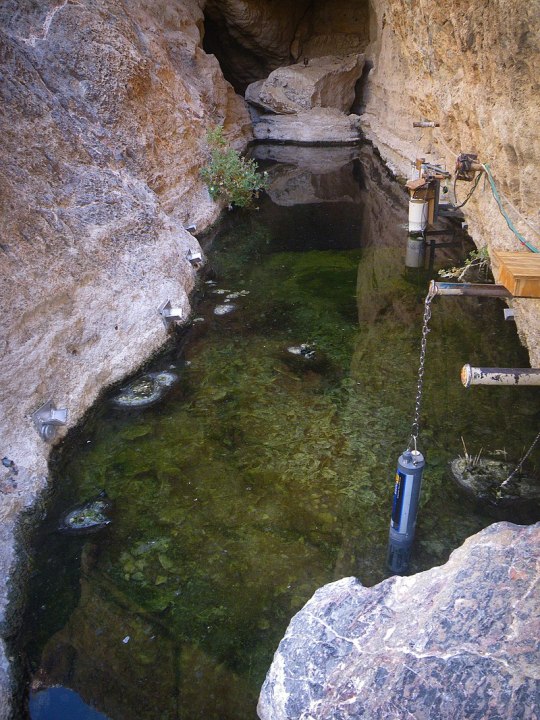
#Devils Hole pupfish#Devils Hole#fish#icthyology#vertebrates#animals#wildlife#endangered species#endangered animals#extinction#nature#ecology#environment#conservation#science#scicomm#Nevada#United States#Endangered Species Act#Endangered Species List
1K notes
·
View notes
Text
getting emotional over footage of an amateur scuba diver interacting with a coelacanth. they are hunted by large deepwater predators, and here comes a large creature bearing the brightest lights it's ever seen, making strange noises, but it does not shy away. it hovers, calmly, as the diver reaches out and trails a hand down its back. im strongly against the anthropomorphizing of real life animals but the stupid emotional part of me loudly insists this is because it recognizes us, the alternating movements of its four paired limbs matching the diver's four paired limbs, & it is thinking, "hello, cousins, we missed you these 66 million years, it's so good to see you again. welcome back, welcome home."
#[OBLIGATORY DISCLAIMER: he should NOT have touched the fish. do NOT touch random fish you find while scuba diving#especially if the fish is 6ft long & has sharp teeth#ESPECIALLY if the fish is a critically endangered species#being overwhelmed by the majesty of the coelcanth is understandable but that does not excuse his behavior]#[obligatory disclaimer 2: i know nothing about this guy; by 'amateur' i just mean he wasnt part of a scientific expedition at the time]#[obligatory disclaimer 3: i mean it wasnt CALM. its first dorsal fin was erect which we have reason to believe means it is on edge.#but it didnt flee like you would expect of a wild animal]#...disclaimers over. now im going to wail about how life began in the sea and we left & they stayed#& we thought they were gone & now we're finding our way back home to them#they are so beautiful and they are our family and they love us ok. they do i know it in my heart#coelacanth#Latimeria chalumnae#animals#andy original#ALSO I KNOW THEY HAVE 8 FINS by four paired limbs i mean the pelvic and pectoral the others arent paired they dont move like legs do
3K notes
·
View notes
Text
[Warning: Graphic (some very graphic) shark-fishing pictures at the link.]
"Suhardi isn’t your average snorkeling guide. Born on the Indonesian island of Lombok, he’s spent his life on water. While he now seeks out sharks for the enjoyment of tourists, he once hunted sharks to help earn money to feed his family and educate his two children.
Suhardi was a fisherman for more than 20 years. He first started fishing working on his parents’ boat, but was then asked to join the crew of a shark boat where he was told he could earn a lot of money. Back on deck, he looks embarrassed to divulge what a meager wage it was, but finally confesses he earned around $50 for up to a month at sea.
Now he and 12 other former shark fishermen are part of The Dorsal Effect, an ecotourism company that helps ex-shark hunters find a new vocation. Each week, the team takes groups of tourists, schoolchildren and university students to off-the-grid locations and guides them around pristine reefs. Each trip is designed to take guests on an exploratory journey of both the shark trade and marine conservation through the eyes of the Sasak people of Lombok.
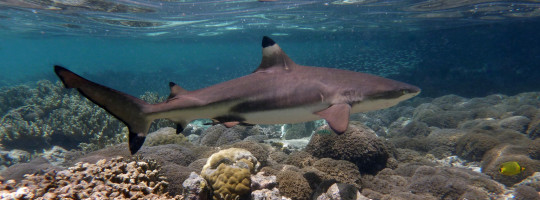
Lombok is a hotspot for marine diversity, sitting just east of the Wallace Line, a biogeographical boundary separating Asia and Australia and their respective fauna. Pristine coral gardens and around 80 species of sharks can be found in its waters. The island is also part of the world’s largest shark-fishing nation. Only the whale shark (Rhincondon typus) is protected in Indonesia; all other sharks can be legally caught.
The Dorsal Effect first launched in 2013, a year after Suhardi met Singaporean ecologist Kathy Xu, who had traveled to Lombok to find out more about the shark trade. The diminutive but quietly determined Xu wanted to protect sharks, but because she knew shark fishing was poorly paid and dangerous, she wanted to hear the fishermen’s stories too. They told her how once they could fish for sharks close to shore, but now with the shark population dropping, the fishermen said they needed to travel farther out to sea, only to come home with a relatively poor catch. The reduced catch also meant reduced pay, so they often couldn’t cover their costs...
Yet, when Xu asked why fishers didn’t seek out another trade, she learned they didn’t want to be separated from the sea. They saw it as part of their heritage.
But as they spoke longer, the shark fishermen talked about the coral gardens that could be found under the waves, ones that only they knew about. Inspired by a whale shark diving trip she’d taken with scientists on the Great Barrier Reef, Xu had an idea. “If such spots exist,” she recalls telling the fishers, “I could take tourists out with you and pay you more than you earned shark fishing”.
At first, Xu guided the former shark fishermen on how to become eco-friendly tour operators. They dropped anchor away from the reef, served guests plant-based dishes, and made sure all trash was taken back to shore. But then Xu saw that something special was happening: The former fishermen had started to take the guest experience into their own hands, making sure tourists felt at home. Suhardi painted “Welcome” in large letters over the front of his boat, fitted green baize to the top deck for outdoor seating, and hung curtains in the cabin so his guests could enjoy some shade.
Suhardi has already bought a new boat with his earnings from snorkeling trips. “Every day is my best day,” laughs Suhardi, whose smile always travels from his mouth to his eyes.
While they were receiving tourists from across the globe, there was another group that Xu wanted to reach out to. “I think it was the teacher in me who felt impassioned about influencing the young,” she says. She reached out to schools and created a five-day program that would help students understand the shark trade and local conservation efforts. During the program, paid for by the school and students, participants would not only meet the ex-shark fishermen so they could ask them about their lives, but also hear from NGOs such as the Wildlife Conservation Society about their efforts to slow the trade. The Dorsal Effect also hired marine biologists to host nightly lectures and help the students with their field surveys...
The students were faced with the realities of the fishing trade, but they were also encouraged to take a balanced view by The Dorsal Effect team. The villagers weren’t just taking the fins, and throwing away the rest of the shark; they processed every piece of the animal. While they did sell the meat and fins to buyers at the market, they also sold the teeth to jewelers, and the remains for pet food.
The Dorsal Effect also takes students on an excursion to the fishermen’s village, a small island that lies off the coast of Lombok. Marine biologist Bryan Ng Sai Lin, who was hired by The Dorsal Effect team, says that on one trip with students he was surprised by how quickly the young people understood the situation. “One of them said it’s good to think about conservation, but at the same time these people don’t really have any other choice,” Lin says....
Conservation scientist Hollie Booth of Save Our Seas, which does not work directly with The Dorsal Effect, says the need to provide legal profitable alternatives to shark fishing is critical: “We are never going to solve biodiversity and environment issues unless we think about incentives and take local people’s needs into account. These kinds of programs are really important.”"
-via Mongabay, December 15, 2023
#shark#sharks#fish#marine biology#marine animals#sea creatures#fishing#marine life#marine conservation#endangered species#overfishing#indonesia#lombok#school#field trip#ocean#pacific ocean#biodiversity#conservation#environmentalism#fishermen#scuba#scubadiving#underwater#diving#coral reef#ocean life#good news#hope
691 notes
·
View notes
Text
Daily fish fact #519
Handfish!
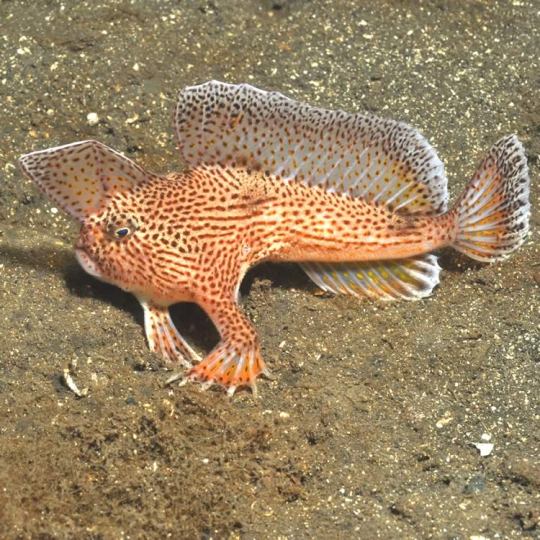
They're anglerfish which have adapted to using their pelvic fins as legs, using them to walk on the seafloor instead of swimming!
#the picture features a spotted handfish! it is unfortunately extremely endangered :(#fish#fishfact#fish facts#fishblr#marine biology#marine life#marine animals#sea creatures#sea animals#sea life#biology#zoology#handfish#spotted handfish
682 notes
·
View notes
Text
#good news#dams#dam removal#environmentalism#science#environment#nature#salmon#endangered#endangered species#fish#streams and rivers#puyallup river
215 notes
·
View notes
Note
s,,, sturgeon
Order up

#please don’t actually eat him he’s endangered#sturgeon fish#siberian sturgeon#acipenser baerii#idk why but I’m on a Siberian sturgeon kick lately
379 notes
·
View notes
Text
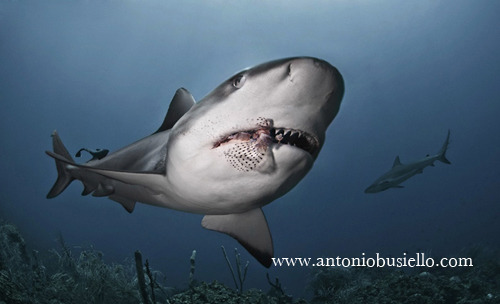
Usually, sharks don't have much interest in lionfish--this is due partially to their venomous spines, but also to the fact that the sharks don't recognize the nonnative fish as prey. The lack of predation by native predators like sharks is part of what makes lionfish such a damaging invasive species.
However, sharks became more interested after spearfishermen working to cull invasive lionfish started feeding the fish they were killing to nearby sharks. After receiving many lionfish "handouts", the fishermen observed sharks hunting and eating lionfish on their own.
This spurs hope that sharks could be "taught" to view lionfish as a viable source of food and contribute to limiting their numbers.
#cw animal death#shark#marine conservation#reef conservation#biodiversity#endangered species#invasive species#lionfish#fishing#good news#hope#environment
484 notes
·
View notes
Text
funniest answer for "what happened during Jason's fight with Krios" is, rather than Jason having a physical one-on-one unarmed fight with Krios, Jason just tears Krios a new one re: legislation by chewing him out for unauthorized activity in a state park. Because one of Jupiter's big aspects is law!
Jason sends the entirety of the Titan Army forces in California marching out of Mt. Tam State Park with their tails between their legs with one strongly worded argument and some threats to inform San Francisco Fish & Wildlife. And he gets made praetor for it.
#pjo#riordanverse#jason grace#was joking about Jason both forgetting about but also being overly familiar with san fran's fish and wildlife legislation yesterday#what do you think are the chances that because of the Mist and him being raised by Lupa's pack that legally Jason's considered a wolf#a la Doofenshmirtz legally being an ocelot. cause the mortals are probably aware of Lupa's pack right?#they're a magic immortal wolf pack but they *are* just wolves. but Jason was a whole baby human.#the Mist would probably disguise him but not the pack as a whole. so it'd be funny if just as far as California is concerned#Jason is just a wolf pup from this random pack. and he pulls that out at random opportunities as a running joke#''Sorry. I'm protected under Wolf Conservation Law. Under the California and Federal Endangered Species Act it's illegal to harass me.''
222 notes
·
View notes
Text

devils hole pupfish
#my art#digital art#environmentalism#devils hole pupfish#fish#fish art#retro art#retro inspired#nature art#conservation art#endangered#krita#artblr#artists of tumblr#artists on tumblr#tumblr artists#pop surrealism#lowbrow art#animal art
89 notes
·
View notes
Note
How about rating a sturgeon on your scale? Really fun idea by the way! :)
Thank you very much :D
Today on CHUNK, FUNK, GUNK! We rate
the STURGEON:

5/10 Chunk
9/10 Funk
0/10 Gunk
I have to start by saying that I don’t really know much about Sturgeon. They’re incredibly unique and recognizable fish, so they get a high funk rating. Doesn’t look very pleasant to hug, so low chunk. Do not seem to secrete slime or mucous, no gunk.
After some quick research, I have learned substantially more and uphold my previous ratings. I also wish to mention that sturgeon have existed for thousands of years and are now bordering on extinction due to human interference.
(Edit: 4/10/23 - Changed chunk from 2 to 5/10 after revising my standard)
#chunk funk gunk#chunk#funk#gunk#sturgeon#atlantic sturgeon#cool fish#ocean#ocean animals#lake animals#fish#River fish#endangered#asks open#I mostly knew sturgeon cuz of animal crossing and Stardew valley
229 notes
·
View notes
Photo
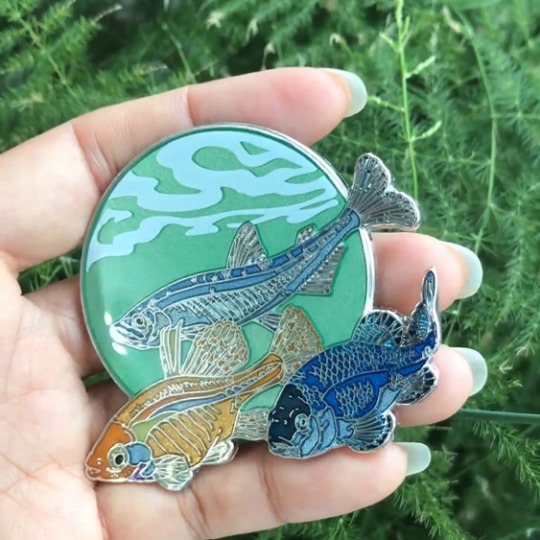
Shameless plug!
Support me on Patreon and gain access to... a lot of things I put up for free. But you can get them first, and more importantly, I can actually work on them. I love making resources more than products. And I’d like to continue to make more anatomy sheets and guides <3
https://www.patreon.com/CircadianCrunch
#shameless plug#fish#pin#skiffia#pipfish#delta smelt#onioncakes pins#collaboration#golden skiffia#endangered#endangered fish#enamel pin#collectables#limited edition
60 notes
·
View notes
Text
There's been a recent increase in the removal of old dams and other barriers on salmon streams on the west coast of the U.S. While last year's removal of part a weir from McKay Creek wasn't as dramatic as the removal of dams on the Klamath River, the results of the removal are very promising.
The weir was installed about thirty years ago due to the creek being drained by a nearby reservoir. Unfortunately, its design meant that salmon could no longer go higher up the creek to their historic breeding grounds.
The power of nature's resiliency--if we give it the chance to recover--was evident in the fact that this past February saw the return of the salmon to the creek for the first time in three decades. What's even more exciting is that scientists found not just a few redds (salmon egg nests), but seventy-two of them in a six mile stretch of the creek above the weir! That's incredibly impressive, considering how long salmon were blocked from that area.
Here's to more projects like these giving our salmon a fighting chance for survival in spite of everything we've thrown at them over the years.
#salmon#fish#fishblr#icthyology#aquatic ecosystems#dams#dam removal#conservation#environment#environmentalism#habitat restoration#endangered species#extinction#wildlife#animals#nature#ecology\#restoration ecology
549 notes
·
View notes
Text
🦈 Daily Shark Fact: 🦈
Speartooth Sharks are a rare species of river shark, one of the rarest animals on earth actually. Scientists estimate that only around 200 of these interesting sharks, are left in the world.

#speartooth shark#small shark#small boi#rare shark#endangered marine life#endangered species#endangered shark#shark blog#advocacy for sharks#respect the locals#shark awareness#save the sharks#sharks#cartilaginous fish#shark facts#daily shark facts#facts about sharks#shark post#sharks of tumblr#shark tumblr#the more you know#fyp#just a girl who loves sharks
131 notes
·
View notes
Text
youtube
Divers Discover Incredibly Rare Handfish While Exploring Sunken Ship
While exploring a sunken shipwreck off the coast of the Tasmanian Peninsula, a group of divers stumbled upon an unusual sight. At first, they couldn't believe their eyes, but upon closer inspection, it became clear that they had discovered an extremely rare creature sheltering in the hull of the ship. The animal, which was a small, light pink aquatic creature, is known as a handfish. They are critically endangered, making this a very rare sighting...
Read more: https://mymodernmet.com/handfish-divers/
42 notes
·
View notes
Text
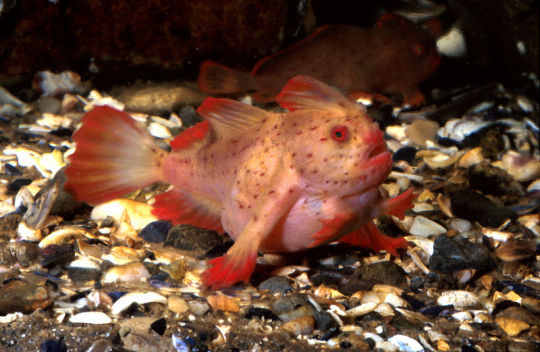
This charming little fellow is the red handfish (Thymichthys politus). These fish spend their days wandering around the seabed looking for crustaceans and worms to eat, all while looking like the traded their last braincells for a bag of chips.
Unfortunately there are currently less than 100 individuals in the wild and their natural range of coastal Tasmania, Australia has shrunk to only a few small reefs in Frederick Henry Bay.
#marine life#fish#marine animals#marine zoology#marine biology#australia#sea creatures#sea animals#endangered species#conservation#ray finned fishes
467 notes
·
View notes